EPISODE 4: BUFFALO TO PHILLY
I spent a pleasant couple of hours in the famous Albright-Knox Museum of modern art in Buffalo. It is located in an Olmstead designed park. I just happened to time it right as a knowledgeable woman was giving a free tour a half hour after I got there. She had some interesting things to say about their abstract art collection (a Pollack and a couple of Rothkos head the list). I did not really understand a lot of it but she had some insightful points. In fact, she was a decent docent.
At the museum I asked if they had any information of Wright or Louis Sullivan buildings, which I read were in Buffalo. They gave me a map of several nearby Wright houses that I checked out. Here are some pictures. Darwin Martin was the head of the Larkin Soap company who was a major client of Wright – the famous Larkin Soap Building was one of Wright’s first commercial buildings, I believe, but was torn down in 1950. The complex of three buildings (Martin house, Barton House, and Gardener’s cottage) were built around 1906. Later, he designed a summerhouse for Martin south of Buffalo in the waterside area known as Angola. This structure was built in 1928 and by that time Wright had left his Prairie Period behind. By the time I got to the summerhouse it was after 6:00 and as I turned into the driveway a woman was driving out and told me that it was closed at 5:00 and she was about to lock the gate. Even if she let me drive down to the visitor center I could not really see anything unless it was opened. I told her about my cross-country trip that featured Wright buildings, obscure and otherwise, that I had had a hard time finding the place, and that I probably would never be back this way again. She was very nice and decided to let me have a quick look. It turns out that since the 1950s this building was used by an order of priests, that had a Hungarian connection, as a boy’s home and school. They brought boys over from Hungary, maybe after the1956 revolt. It was used by the priests until 1999 at which point it was offered for sale; real estate people advertised the site saying the building could be torn down to make a larger building site. Luckily a trust purchased the property and it is now preserved. After she let me look at the building I asked the woman what her name was and told her I would put her in my blog. Her name is Katie and I was glad that Katie did not bar the door.
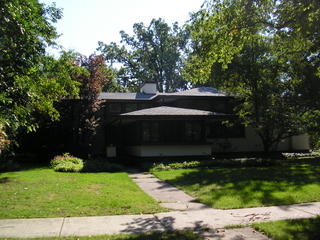
Davidson House
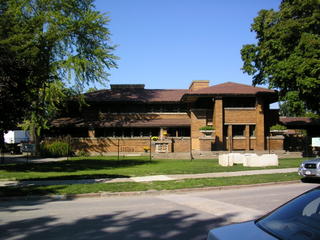
Martin house
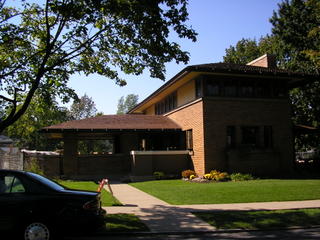
Barton house
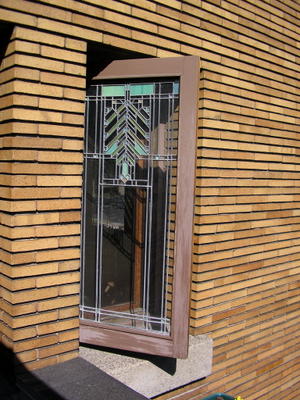
Barton House detail
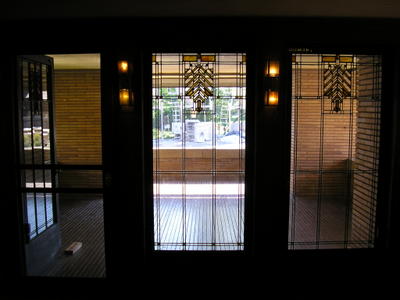
Barton house detail 2
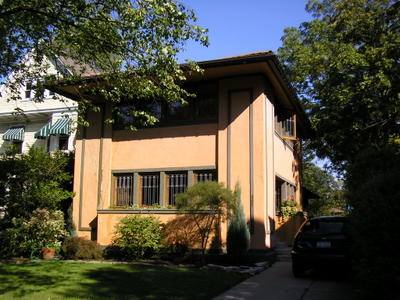
Gardener's Cottage

Martin Summerhouse
A little bit about food in Bufallo. I had to go to the Anchor Bar where Buffalo Wings were invented. I had a plate of 10 – they were not necessarily much better than others I have had but they were at least as good as any I’ve tasted. Another Buffalo tradition is a great roast beef sandwich called Beef on “Weck” which is short for “kummelweck”, a Kaiser roll laced with coarse salt (so you will buy more beer) and caraway seeds. The rolls are soft inside but still sturdy enough to hold up when sliced in half and dipped in natural beef gravy. I tried this at Schwabl’s in nearby West Seneca. It is an old fashioned roadhouse with very capable waitresses wearing nurse-like uniforms. The beef was delicious, thin rare slices piled up inside of the roll. Part of the deal is to watch the carver sharpen his tools and cut the beef.
Here are some pictures from the road in upper New York State. These may be a bit out of order. I will have to say that I was disappointed with the Kazoo. But it was fun trying to find the town of Eden. I was not sure whether to continue on a straight road or turn. I asked a woman in a car at an intersection and she told me to continue straight. I told her that I must have been headed to the east of Eden then. And it was Sunday so the Kazoo factory was closed; pity. With respect to Attica: I had no idea it was here but saw the sign for the town so I headed off Highway US 20 (still on this road – all the way from Levenworth) four miles to the town. There were no sign to the prison so I had to ask someone in town. It is a really surreal place.

World's largest Kazoo in Eden
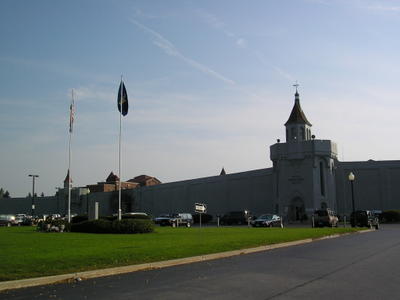
Attica

Got Milk in Bridgewater?
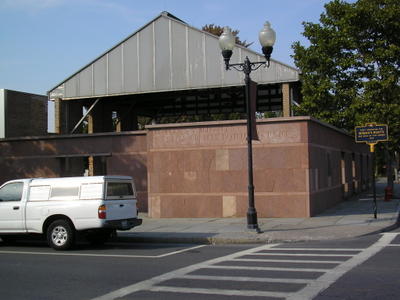
Women's Rights National Historical Park, Seneca Falls

Harriet Tubman’s house in Auburn
There is a complex of Mormon temples and visitor centers near Palmyra where Joseph
Smith first had his vision and where the Angel Maroni came to visit. And the rest is history, witnessed by all the missionaries all over the world including a couple I kept on seeing in my internet café in Chenai, India. Anyway, here is where he had his first vision:
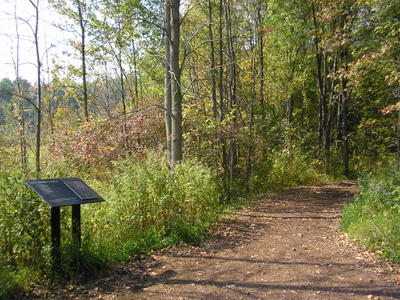
Jospeph Smith's sacred grove
I saw some parts of the Erie Canal and there is an interesting museum in Syracuse that shows a weighhouse where the barges were weighed for the toll. Inside this museum was a little tribute to Elizabeth Cotton (“Freight Train” – Cotton picking) who lived in Syracuse.
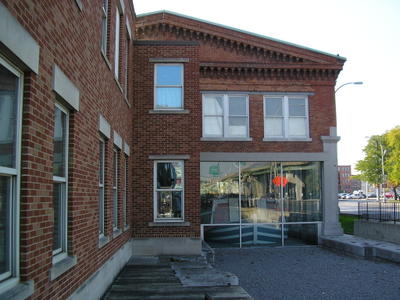
Weigh House museum
Now we are off to Cooperstown and the Baseball Hall of Fame. It is located in a beautiful part of the country and is a pretty town, even if a little over populated with baseball card shops that don’t carry cards from the 1950’s. It was too much to see in one day but I really enjoyed it. I thought the part on historic ballparks could have been better and they could have given a little bit more emphasis to the only team other than the Yankees to win three world series in a row – the 1972-4 Oakland A’s. They had a home plate from the bullpen in Ebbets field – I have a piece of the real home plate that I chipped off from a display in LA in 1958. I got a kick out of seeing the World Series programs that I have from games I have attended (1959, 1962, and 72-74). I mentioned Willy May’s glove from his famous catch off Vic Wertz in the 1954 World Series; also Gionfriddo’s mitt from his catch off DiMaggio in the 1947 Series – the only time the Yankee Clipper ever showed any emotion. Also, the Ichiro display was cool – the tickets to the games where he broke Sisler’s single season hit record made me wonder if I have kept those tickets to the games from the last weekend last year. The display had about every piece of clothing that Ichiro wore for those games except his jockstrap.
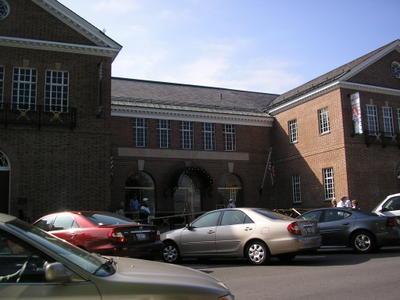
Cooperstown
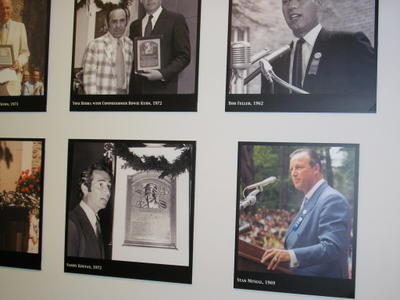
Sandy gets inducted
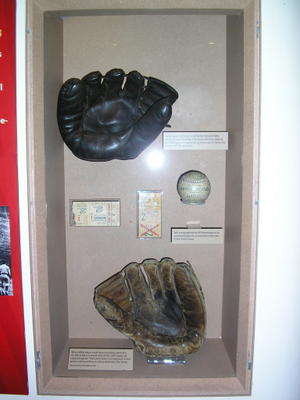
Gionfriddo and Mays gloves

Ichiro
The drive down to Pennsylvania was really pretty with the fall colors kicking in (not from frost –it was 80 degrees and more – but from drought). Here is a picture that might give you some idea of the colors.
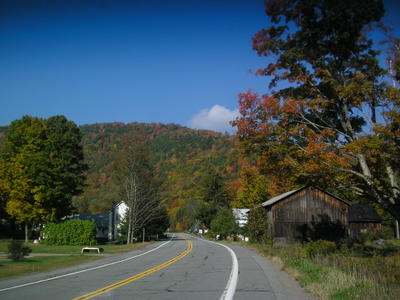
Colored leaves
There were two reasons why I came to NE Pennsylvania: to see Nanticoke and visit Fred Orlowski in Mountainhome. Nanticoke is a small, hard-scrapple town a little south of Wilkes-Barre that is a little south of Scranton. It was the home of Steve Bilko, one of my first heroes who played with the old minor league Los Angeles Angels. He was a powerful homerun hitter who actually died very young many years ago. (All three of my heroes from that era – Gene Baker, Gene Mauch, and Bilko – are now dead with Mauch’s death only a couple of months ago.) The town’s name always intrigued me and I wanted to see what it looked like. Also, I had looked up the name Bilko on the Internet and got the phone number of his widow. I gave her a call and she was nice but did not seem overly impressed that I would drive all the way across the country to see the home of my boyhood hero. I asked if we could meet but she said she was busy that day and I actually think she was a little wary – and thought that I might be a bit strange; I have no idea how she might have got that idea. Even after I told her the following story of me as a 13 year old. Bilko was one or two home runs shy of the Pacific Coast League home run record – I think it was 60 homers. And I went to the last game of the season in 1957, actually the last minor league game ever played in LA’s Wrigley Field. When Steve failed to hit even one homer I was devastated. After the game I waited for the players to come out and get their autographs. I was really surprised when Bilko did not seem upset at all- and here I was extremely distraught. I remember feeling, with the insight of a 13 year old, that there must be something wrong with me since I felt so strongly and the player himself did not really seem to mind very much that he did not tie the record. I told Mrs. Bilko this story, but she still said she was busy that day.
Fred Orlowsky lives with his wife of 60 years, Virginia, in the little town of Mountainhome in the Poconos. It was a very pretty drive to get there. I think I mentioned before that he was the one who led Walter Turk around D-Day morning after Walt was knocked silly when jumping out of the plane. Fred was also standing right near my father when he was killed. He said that it was not like in the movies; he was just shot above the left eye and simply collapsed. They were standing in a drainage ditch of some sort, up to their waist in water. When he went over to my father he had to go into the water up to his neck. But my dad was already dead. On my visits with both Walt and Fred I have made a tape (actually digital) recording of my “interviews” and it is really nice now to have these men recorded for posterity. Fred was born and raised in Brooklyn and was a New York cop for decades. He told me that me did not really feel he accomplished that much as a cop but he feels he really did accomplish something in World War II. Here is Fred today.
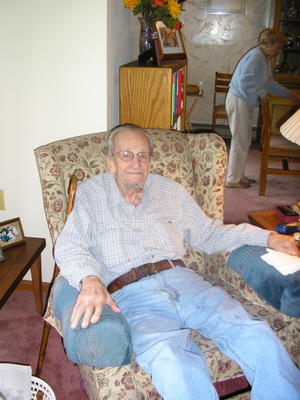
Orlowski
I want to mention Fred’s good buddy, Jack Urbank, who died last year. Here is a picture of Jack and Fred when they were in the service and then when they met in 2001. It is from a book by Jerry McLaughlin (more on this later) and I am not able to copy it very well but I want to include it anyway.

Jack and Fred
One of the most moving experiences I have ever had was witnessing these two guys meet for the first time in 56 years at a reunion in 2001. They took up as if they had not seen each other for only 3 or 4 weeks. Urbank had Parkinson’s disease but was still sharp. He actually remembered holding me as an infant and recalled that my mother had red hair. He had a great sense of humor and I was greatly saddened when he died before I could include him in this journey of mine.
After visiting with Fred and Virginia I headed for Philly. There were two reasons why I had Philadelphia on my agenda: Frank Lloyd Wright’s Beth Shalom synagogue and cheesesteak sandwiches. The person who conducts tours of the synagogue never returned my call so I figured I would just go to Saturday morning services. I arrived shortly before the services were to start – but it was as I feared might be the case, the services were to be held in a smaller chapel not the main sanctuary. I asked if I could see the locked sanctuary and they said they did not know how I could do that but I could ask one of the rabbis. As it turns out they have a new woman rabbi who said that she had to get something from her office that is reached through the sanctuary. She was nice enough to let me follow her in but she said not to tell anybody. Who would I tell? (No, her name is not Katie.) It is an awesome space – I was not allowed to take a picture from the inside but I was able to download this second picture from the Internet.
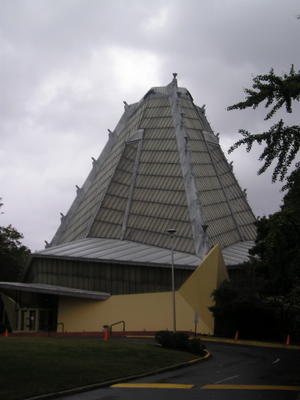
Beth Shalom
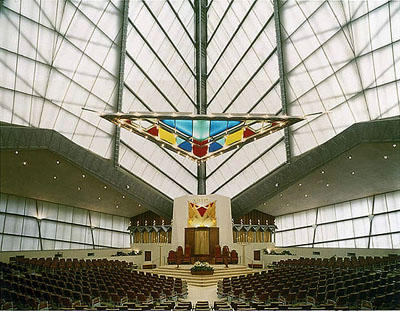
Inside Beth Shalom
I figured since she was so nice to let me see the sanctuary I should stick around for services. Actually. it was pretty nice, a warm congregation. But it lasted a long time, two and a half hours. It was an interesting service to me, being a Conservative synagogue. Not as strict as orthodox but more traditional that the reformed temples that I used to belong to; one guy insisted that I wear a prayer shawl – I have not done that since my Bar Mitzvah. But it was certainly neat going to a service in such a wonderful building – even the smaller chapel (still held over 100 people) was nice. The senior rabbi talked of the narrow line between good and evil; for example, technology may be a good thing but it can lead to environmental pollution. He talked about up coming Yom Kippur and the idea that it is easy to identify and atone for sins of commission, but what about sins of omission? That we all should do more to alleviate the poverty and racism that was so evident in our country after Katrina. It actually made me think because I had been thinking recently that this past year I have not really committed many bad deeds – but what more could I have done in a positive manner?
Which brings us to my second reason for visiting Philly: cheese steak sandwiches. I headed for south Philly. First of all I turned the wrong way off the freeway from New Jersey where I was staying and ended up lost in a not so good part of town. I was also low on gas so I asked a guy in a locked booth at the gas station how to get back to South Philly. He actually was brave enough to step out of his booth and give me directions. He said once I got close to the famous cheesesteake stands I would have to ask for directions again since one can’t drive straight there. And he told me to keep my door locked.
He was right about not being able to drive straight there. I don’t know what I was expecting – Fabian on American Bandstand or what. But I have never felt so disoriented and challenged in trying to find someplace in America. South Philly is a warren of narrow one-way streets with cars parked cheek by jowl on both sides of the street. It is very hard to navigate but I finally managed to find my objective: Pats, the oldest cheesesteak stand in Philly. I was amazed to find a parking space right in front. When you order you first say what type of cheese you want (cheese whiz, American, or Provolone) then whether or not you want onions. For example, “Whiz wit” means cheese whiz with onions. I decided to have the real deal and ordered cheese whiz – they put globs of it on. The next day, after Saturday morning services, I went to Gino’s, across the street. It was easier to find in the daytime. I decided that I had enough of Cheese Whiz so ordered provolone. Gino’s does not chop up the meat so much and leaves it in thicker slices and I did not think they put on enough cheese. The following pictures are of the neighborhood around Pat’s and Gino’s. They just painted this mural of mostly South Philly stars like Fabian and Frankie Avalon.

South Philly streets

Gino's
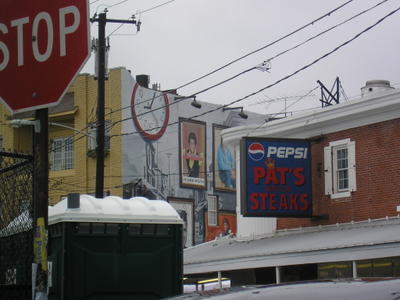
Pat's
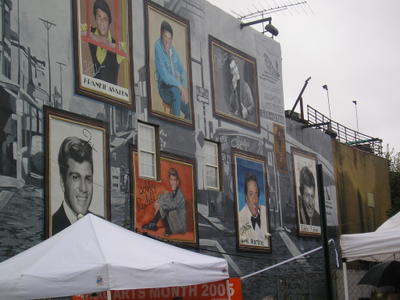
Mural
Before I left I figured I should try the other famous restaurant: Jim’s Steaks They are the second oldest, after Pat’s, but are located in the South Street area of trendy shops closer to downtown – and are a bit more upscale. The line stretches outside the door and I was worried that I might get a ticket since I only put in one quarter for 15 minutes. After 45 minutes of waiting I was getting very worried and, in fact, I did get a ticket. But the meter maid forgot to check the box for the violation and I will write them to tell them that it is, therefore, void and, anyway, I have an excuse since I had no idea the line would be so long. And this last sandwich was the best – the meat was great and they put on more cheese – so I will have to award them the prize.
One more Philly site before we leave: Girard College, which my uncle Jack attended and was a major influence in his life. Stephen Girard established this school for “white orphan boys” according to his will. It is a boarding school for boys from the beginning of school until about age 18. In the 1960’s as part of the civil rights movement Girard’s will was overturned and now boys of all races can attend.
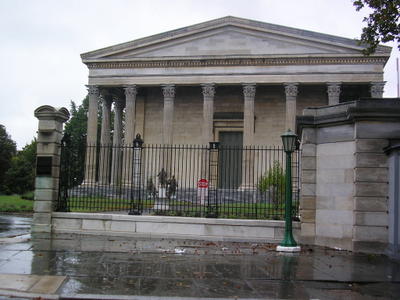
Girard College
Baltimore and DC are next in line. One thing that I may have to deal with at least once is WalMart. I have never been in one but they are everywhere. I saw them in Canada and outside almost every town of any size. I wonder what they are like inside. I can’t really say that I have experienced America unless I visit one, can I?

1 Comments:
No pictures of the cheesesteaks, Cliff?
8:47 PM
Post a Comment
<< Home